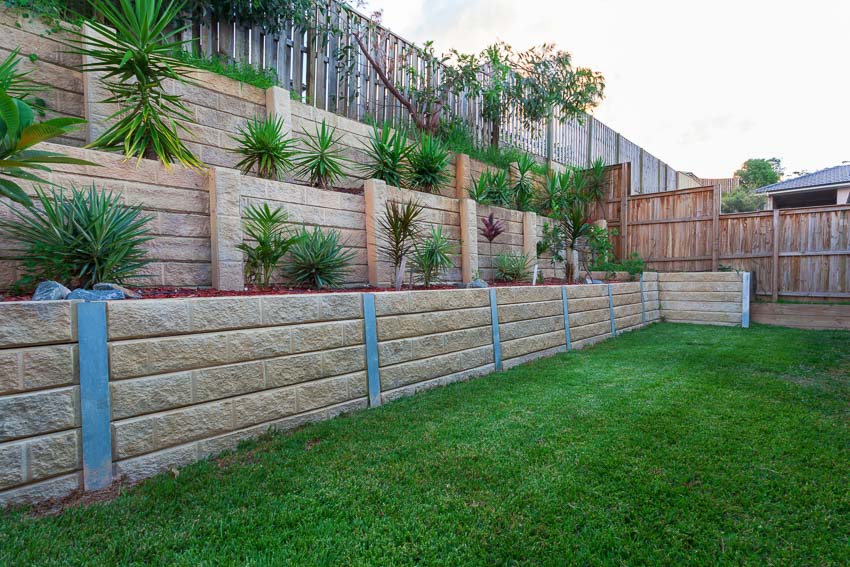A retaining wall on your property is one of the most effective strategies for addressing erosion issues, and they are attractive hardscaping features that add value to your home. Learn about retaining wall costs, the different types you can build, and whether it’s better to build one yourself or hire a professional.
Exploring Different Types of Retaining Walls
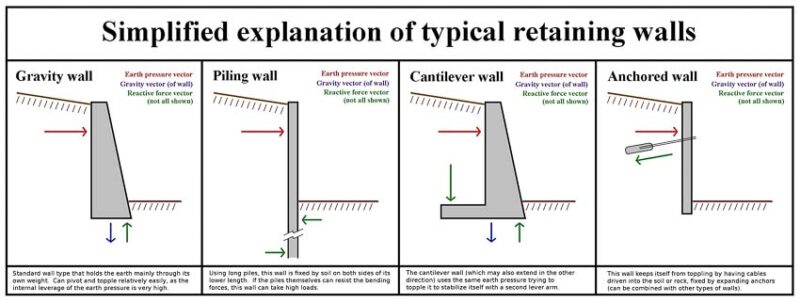
There are many types of retaining walls, each with advantages and disadvantages. In this guide, you’ll learn about five types of retaining walls and explore the pros and cons of each to help you determine which is best for you.
Timber Retaining Walls
Wood retaining walls are affordable and easy to install. They are aesthetically pleasing and can last 20 years or more if installed correctly.
There are two common methods for building timber retaining walls. The first method uses stanchions, or posts, anchored into concrete and placed at intervals along the bottom of the wall.
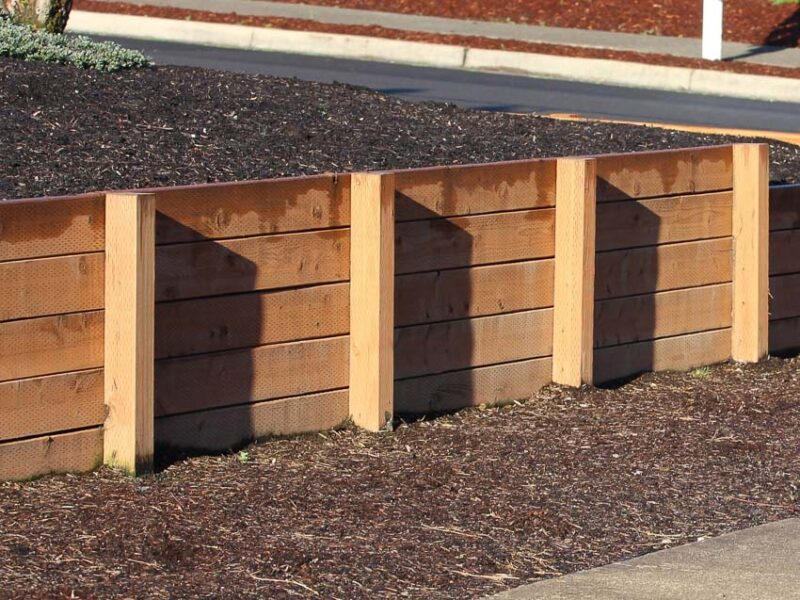
The timbers, usually 2×6 treated planks, are placed against the stanchions, and aggregate and soil are backfilled behind them to keep them in place and allow for proper drainage.
With the second method, holes are drilled in large 6×6 timbers. Metal rods are placed in the ground, and the timbers are kept in place by stacking them on top of each other with the metal rods going through them.
Timber retaining walls cost $13 to $35 per square foot. Using railroad ties instead of treated lumber costs about $18 to $25 per square foot.
Concrete Block Retaining Walls
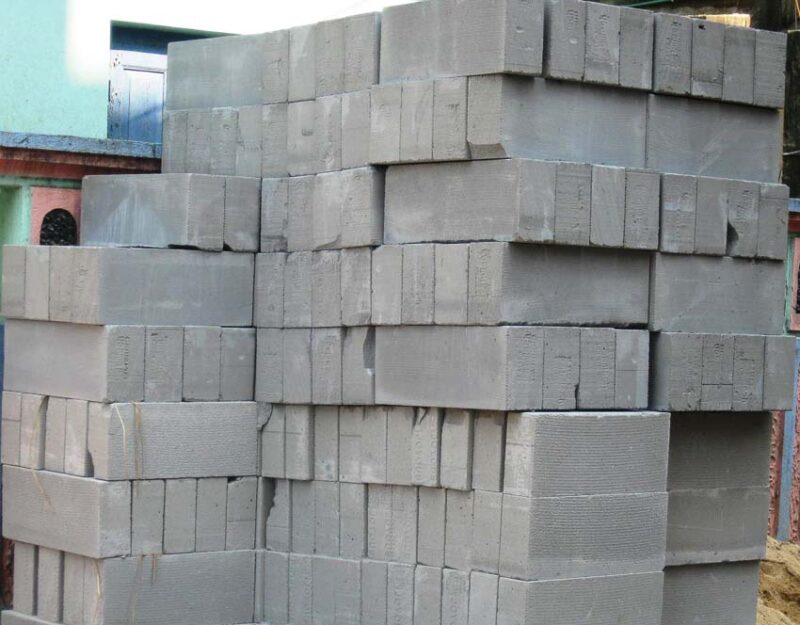
Concrete block retaining can last 40 to 100 years, easily doubling the expected lifespan of a timber retaining wall. Because concrete doesn’t decay or warp, it’s an excellent material for holding back soil.
One of the main advantages of concrete retaining walls is that they are easy to install. You can build them in many ways by stacking concrete blocks in different patterns. You also have other design options, including adding capstones and landscape lighting to improve the aesthetics.
When concrete block retaining walls fail, it’s usually because of drainage problems. It gets extremely heavy if the dirt behind the wall becomes saturated with water that has nowhere else to go. You have to consider the weight and drainage issues when designing your wall.
Concrete block retaining walls cost about $15 to $40 per square foot, or $45 to $200 per linear foot, depending on the height and type of block used. Choose from landscape and cinder blocks to create concrete block retaining walls.
Natural Stone Retaining Walls
Natural stone is a good choice for retaining walls, especially if you have a lot of it on your property. If you have to buy stone, the best natural stones for retaining walls are flat rocks like flagstone or cut masonry stones like ashlar.
Stone retaining walls can last a long time, depending on how well installers have constructed them, and the conditions of the slope they support.
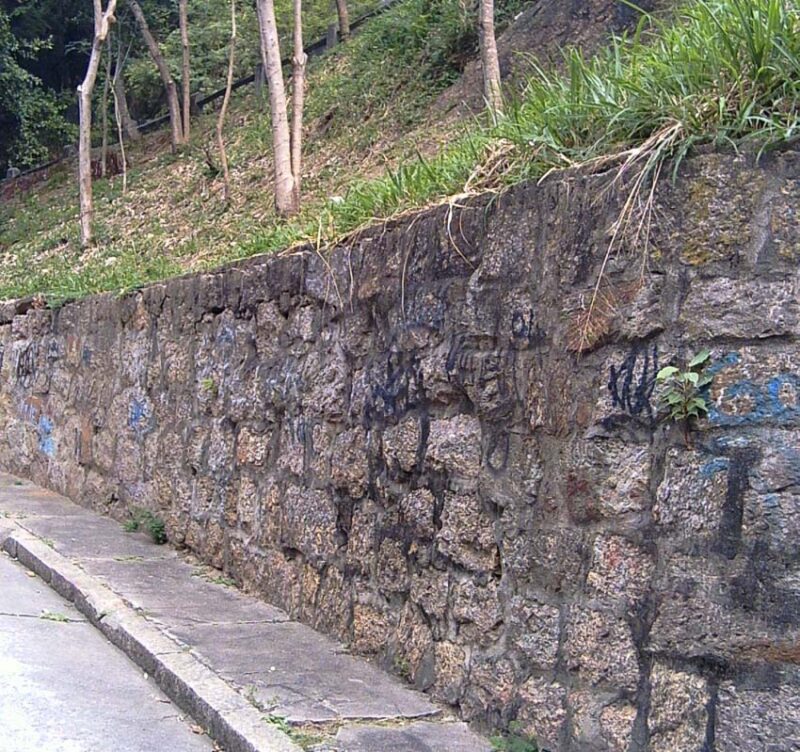
Working with stone is an art. Amazingly, the ancient Incan architects crafted some stonework so well that it has remained intact, even though the 500-year-old Spanish masonry built on top of it is now crumbling.
Rock retaining walls are aesthetically pleasing in your garden or built alongside a road for erosion control. Natural stone retaining walls cost $20 to $90 per square foot, depending on the availability of materials in your area.
Gabion Retaining Walls
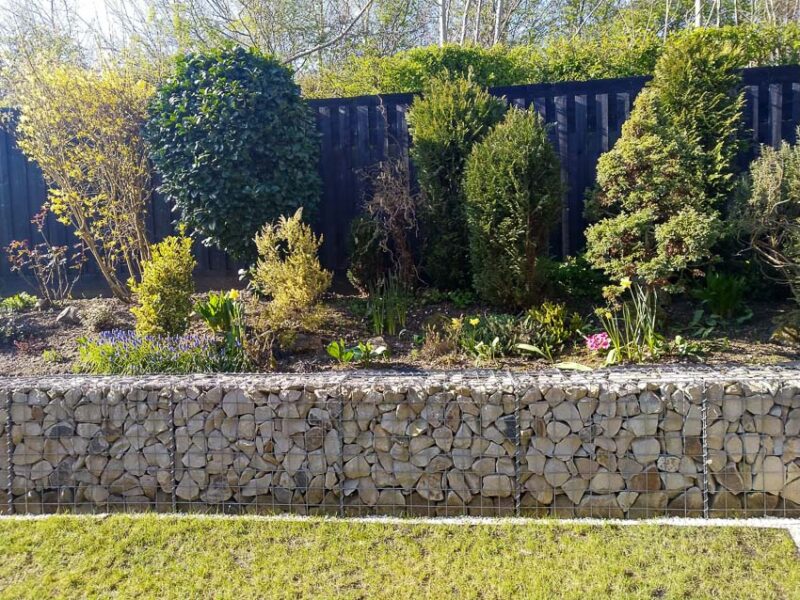
There are many types of gabions, from gabion baskets and walls to wire mesh and sacks. They are used to construct retaining walls, fences, and dams. Most people are familiar with gabions because they are used in erosion control projects along roadsides, embankments, and canals.
All gabion baskets work on the same principle. They are metal wire boxes or mesh cages filled with riprap, soil, concrete, or other materials. Sometimes they are vegetated with live roots inside the rocks to encourage the growth of shrubs and trees that will help stabilize the soil.
Gabion baskets are a simple, effective approach that can last up to 75 years, depending on the installation and environment. On average, gabion retaining walls are much less expensive than other types, costing about $10 to $40 per square foot.
Segmental Retaining Walls (SRWs)
Modular block retaining wall systems–or segmental retaining walls (SRWs)–are an innovative approach to erosion control. Designers use them for steep grades that require vertical installations.
SRWs comprise interlocking blocks that fit together, which improves their performance and makes them easier to install. SRW blocks are dry stacked, but typically held together with pins or adhesives.
There are several advantages of using an SRW retaining wall. It’s easy to accommodate any design, including one with curves, and the blocks come in various shapes, colors, and textures to complement your landscaping.
SRWs cost about $15 to $35 per square foot, making them an economical, durable, and visually appealing solution.
Costs of Hiring a Professional vs DIY Retaining Wall
Once you decide on the type of retaining wall, you need to decide if it’s a project you want to tackle yourself or if you should hire a professional.
Benefits of Hiring a Professional
Many homeowners build their own retaining walls, but it’s time-consuming and physically demanding. There are numerous advantages to hiring a professional landscaper to build your retaining wall.
- Professionals work quickly to get the job done, get paid, and move on to the next job.
- Professional landscapers have expert knowledge about local regulations and best practices.
- Professionals have the right equipment to build large, complex retaining walls.
Benefits of Building a DIY Retaining Wall
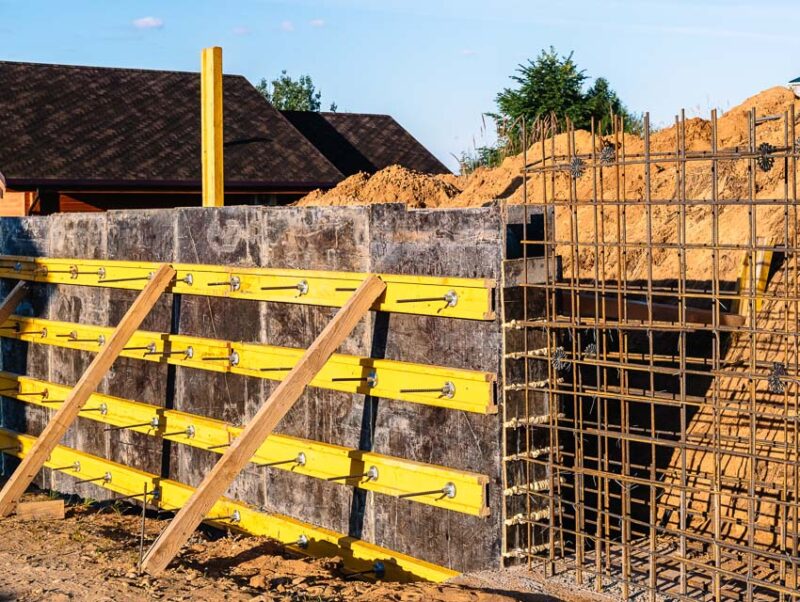
In some cases, you can save a lot of money by building your own retaining wall. You can take your time building it exactly how you want it and customize it with materials that fit your budget.
You’ll need to do a lot of research to learn how to build a retaining wall, but it’s not a task that requires extensive DIY skills. More than anything, retaining walls are labor-intensive and physically challenging to build.
Factors to Consider for DIY Retaining Wall
Building a DIY retaining wall is a great way to add equity to your home by increasing your property value. It’s important to start with a good plan, and before you begin, there are several factors you should consider.
- Type of soil
- Slope
- Drainage issues
- Budget
- Permits and regulations
- Wall height
- Nearby structures and roads
If you already have drainage pipes and systems on your property, like French drains or culverts, take some time to consider how they will tie in with your retaining wall project.
If you have serious erosion control issues or steep slopes, consider a professional consultation with an engineer before you start. Disturbing the soil can cause extensive problems that make matters worse.
Why Invest in a Retaining Wall for Your Landscape
Properly installed retaining walls look good, and you might want one for your property, but is it worth the investment? Consider the following reasons to invest in a retaining wall for your landscape.
Explore our low-maintenance landscaping tips!
Erosion Control and Stability
Retaining walls aren’t always necessary, but they are an excellent way to stabilize your yard. Erosion in your yard is primarily caused by water carrying soil particles with it as it flows into storm drainage systems, and if you have a steep slope, erosion could be causing serious problems.
Erosion doesn’t just affect your yard, however. It has detrimental effects on water sources all over the United States. Water that flows out of your yard carries soil, contaminants, and lawn fertilizer chemicals into streams, lakes, and rivers, resulting in dead zones that are detrimental to wildlife.
Maximizing Outdoor Space
If you live on a slope, you can maximize your outdoor space by creating flat spots. Unfortunately, every flat spot terraced into your hillside means a steeper area somewhere else, usually creating a need for a retaining wall.
When maximizing your outdoor space on a sloped hillside, make a comprehensive plan that includes drainage, retaining walls, and vegetation. Planting the right trees, shrubs, and perennials will not only stabilize your yard but will also improve the appearance of your yard.
Aesthetic Enhancement and Curb Appeal
If your property slopes down to a sidewalk, it presents challenges with mowing and keeping green grass on your hillside. Turn your slope into a retaining wall, though, and you can plant it with attractive perennials and flowering trees that will transform the appearance of your front yard.
Cost Considerations for Retaining Walls
How much does a retaining wall cost? That depends on several factors.
Take a closer look at the material and labor costs associated with installing retaining walls, and learn more about additional expenses you may run into that will increase the overall cost of a retaining wall.
Material Costs
The materials are the main factor influencing the cost of building a retaining wall. You can choose from many different materials to construct a retaining wall.
There are many ways to save money on material costs. For example, using the readily available stone on your property to fill gabion baskets will cost much less than purchasing rock.
Here’s a brief recap of the material costs associated with the different types of retaining walls covered in the first section of this guide:
| Materials for retaining wall | Average cost of a retaining wall per square foot |
| Timber or railroad ties | $13 to $35 |
| Concrete blocks | $15 to $40 |
| Natural stone | $20 to $90 |
| Gabion | $10 to $40 |
| Segmental retaining walls | $15 to $35 |
No matter what type of materials you choose for your retaining wall, you may also have to purchase landscape fabric, erosion control blankets, and pea gravel to combat drainage issues.
Labor Costs
Labor costs for landscaping workers are usually about $50 to $100 per hour. If you hire a professional landscaper with heavy equipment, you could be charged as much as $200 to $300 per hour, depending on the type of equipment.
Regional factors like the cost of living and labor shortages greatly impact labor costs. The time of year is another important factor influencing labor costs.
Additional Costs to Consider
Where your retaining wall is placed will impact the project’s overall cost. For instance, installing a retaining wall on a steep slope or shoreline costs more than in the average backyard.
You’ll also run into additional costs if your land needs to be cleared, graded, or excavated. Expect to pay from $1 to $4 per square foot for excavation and leveling services. You could also run into hauling costs to dispose of excess topsoil.
FAQ: Common Questions About Retaining Wall Cost

1. Are there height limitations for DIY retaining walls?
Most retaining walls are only about three to four feet tall. Any higher than that, and you encounter significant risks. If you have a steeper slope that requires a higher retaining wall, you may need to consult a professional.
2. Do I need a permit to build a retaining wall?
Many municipalities require permits for retaining walls over four feet high. You can usually build anything less than that without one. You may also need an erosion and sediment control permit, depending on your situation.
3. How long does a retaining wall typically last?
Depending on several factors, retaining walls can last anywhere from ten years to over a century. The factors that have the greatest impact on the longevity of your retaining wall are the slope, type of soil, and materials used to build it.
4. Can I use different materials for a unique look?
Using mixed media in landscaping is a great way to achieve a unique look. For example, timber and gabion basket retaining walls are attractive. You can also use curved lines to add interest and use plants like creeping ground covers and low-growing shrubs to create a striking retaining wall.
5. Are there specific drainage considerations for retaining walls?
As water seeps into the ground, it continues to flow downwards, and if your retaining wall doesn’t allow the ground to drain, you can end up with saturated soil behind your wall. Drainage issues are the primary reason that retaining walls fail.

